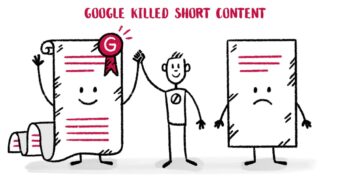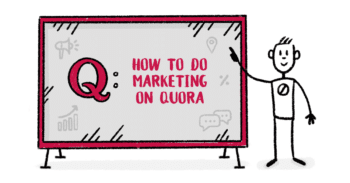How to Create a SaaS Content Marketing Strategy in an AI World

What’s the point of spending more money on content when you can use ChatGPT to create it for you in a few seconds?
I’ll tell you why.
Because brands that differentiate their content with unique expertise and depth are the ones that will continuously attract their ideal customers, close more deals, and scale 2X faster.
This guide helps you understand why you should use AI wisely and how you can create a SaaS content marketing strategy that stands the test of time.
Planning Stage
Customer research lays the foundation for your business, including content. Here are four strategies to ensure your content hits the bull’s eye right from the start (note: this section doesn’t touch on AI. That comes later!).
1. Give every customer-centric team a seat at the table
Traffic is pointless if it doesn’t translate to sales.
Alas, that’s the problem with traditional marketing.
Too many marketers blindly run after high-volume keywords that have little to do with the product they’re selling, when they should focus on what matters: pipeline and revenue.
The key to attracting quality leads that convert to pay customers?
Driving customer centricity in a revenue marketing strategy.
Revenue marketing is a holistic approach that aligns marketing and sales and other revenue-focused departments to eliminate departmental silos and drive predictable revenue.
The result: a consistent and layered customer experience that attracts customers and keeps them coming back for more.
Gather every stakeholder (e.g., content marketers, customer success, sales, product) in a room to determine your content marketing goals.
Are customers getting the most of the product? What’s the best way to communicate your unique selling proposition?
What’s the biggest objection that sales face from sales-qualified leads? What kind of content can you create to overcome it and close more high ACV deals?
Does customer success need more support to educate customers with upsell potential? What content do they need to improve retention and expansion revenue?
Marketers that set goals are 377% more likely to report success than those who don’t. Get ultra-clear on what each department wants to achieve before moving on to the next stage.
2. Identify customers that drive revenue
Sales work overtime chasing poor-quality leads.
The team receives a constant stream of leads from marketing, but they’re nowhere near ready for a sales pitch. Emails go unanswered, productivity takes a hit, and time is wasted.
What else is there to do?
Build an ideal customer profile (ICP) based on your best customers.
An ICP is a valuable document that includes your customers’ firmographic and behavioral data (e.g., daily habits, and decision factors).
Ensure your ICPs are widely accessible for every revenue-driven department, especially marketing, and sales. That way, both teams can get aligned and focus on campaigns, content, and conversations that drive sales.
Consider investing in a tool like Breadcrumbs Reveal to identify the customer segments that drive the biggest revenue for your business.

It’ll help you pinpoint the specific customer attributes and actions you should care about.
3. Find out everything about them
Companies that invest in customer research build better products, scale faster, and earn more revenue.
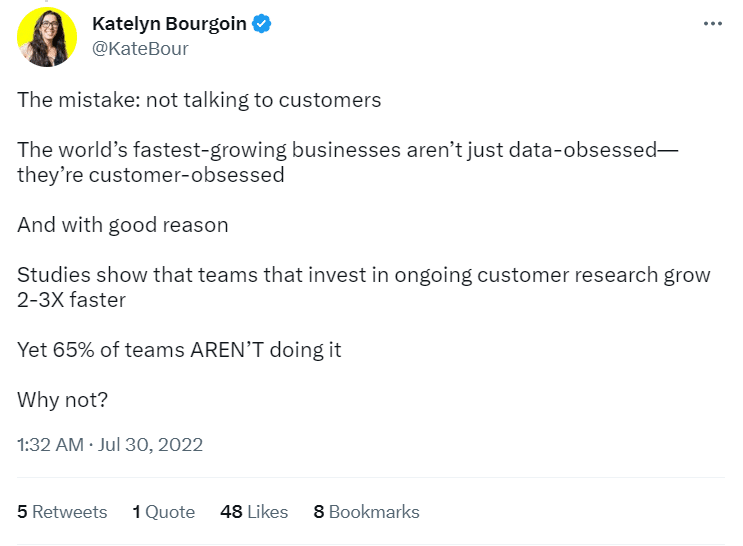
Audience insights can impact anywhere from content to product. And there are multiple ways you can get started.
Interview customers to uncover their jobs-to-be-done, desires, etc. Questions like “What was happening in your life that made you realize you need a solution like ours?” identify triggers and help you gain a better understanding of the first few touchpoints in the customer journey.
Whereas sales team interviews identify the top product features (e.g., “What were the top features that always seem to attract customers?”), potential customer objections, and the accounts easiest or hardest to close.
If you have a modest budget, mine for customer data in online communities like G2, Product Hunt, and Slack groups.
You can also create an email sequence to gather insights. Note this email that SwipeWell automatically sends to users who upgraded to a paid plan.
It poses a brief question midway: “Was there anything that almost prevented you from becoming a customer?”
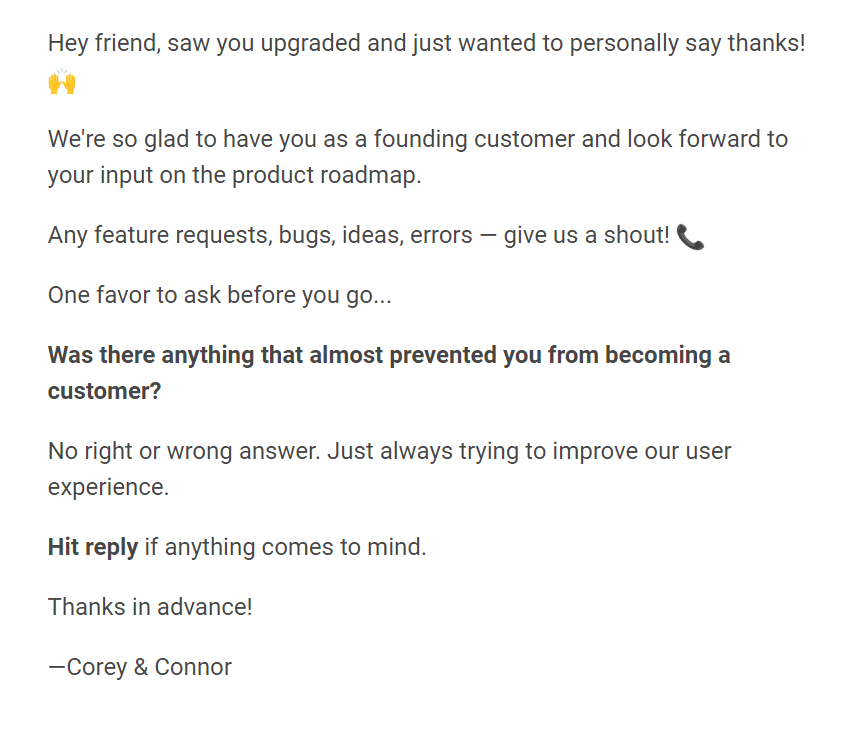
This strategic question unearths common objections from paying customers.
Whether it’s concerns related to product, pricing, or content, the team can immediately jump in to address the concerns and prevent it from happening again, ultimately shortening the sales cycle for future customers.
Feedback from customers can also inspire effective content ideas. Marketers should work closely with the customer service team to identify frequently asked questions and patterns to gain a better understanding of customer needs.
Once you’re done, compile your research and voice of customer data in a content ideation spreadsheet and analyze for common themes.
4. Prepare marketing assets
Consistency plays a vital role in earning customer trust and ramping up business growth, so much so that it can increase revenue by up to 20%.
The best way to improve consistency? Create marketing assets to convey your brand, vision, and values.
Blog, voice, and tone guides are non-negotiable, especially when you outsource your content to an external team of writers and designers who are new to the business and might need some time to familiarize with your product.
These high-quality content assets maintain communication and product positioning across the marketing funnel.
For example, a SaaS brand known for its fun and upbeat video ads should stick to a similar tone in its blog. Imagine if it stuffs every post with corporate speak and jargon. It would create a disconnected and confusing experience.
Content Creation Stage
Now the real work begins. In this stage, learn how to create content that stands the test of time in today’s AI-powered world.
5. Determine the type of content to create
More than two-thirds of Google searches ended without a click.
With search engines like Google and Bing providing answers to queries without requiring users to click through any website, traffic is at an all-time low and will continue to stay stagnant in the days and months to come.

Zero-click content originally started on social media before it made its way to search engines. Suffice to say, it’s here to stay. And the best way to deal with it, according to Amanda Natividad, VP of marketing at SparkToro?
Create educational content upfront to build enough goodwill in your audience and trust that they will remember your brand, follow you, and click through your call to action.
In other words, a 500-word how-to and basic listicle won’t get you far.
However, educational content like:
- Comprehensive industry reports created from first-party data (e.g., The State of Content Marketing 2023 Global Report by Semrush)
- Deep analysis of industry news, trending topics, etc. (e.g., How many keywords can you rank for with one page? (Ahrefs’ study of 3M searches by Ahrefs)
- Thought leadership posts that challenge perspectives and provide food for thought (e.g., Copycat Content: SEO Tools Got Us Here, Humans Will Get Us Out by Animalz)
… will remain valuable for a long time.
Businesses that consistently deliver value will capture attention across platforms, build an enduring brand, and emerge as winners in the content game.
So, what types of content should you create?
Most SaaS startups tend to focus on the following mediums:
Videos
Videos summarize long-form content, introduce new products, and show exclusive behind-the-scenes, among others. Not only do these visual recordings generate buzz, but they also drive sales when done well.
ProfilePicture.ai, an AI-powered headshot platform, generated $10,000 in sales after a user on TikTok talked about corporate headshots created by AI.
What’s interesting is that the user has never used the product.
All she merely did was mention: “AI-generated headshots,” which happened to be one of the startup’s top-ranking keywords.
Viewers googled it, spotted ProfilePicture.ai on the results page, and bought the tool.

If you want to replicate this video content strategy, avoid mentioning your product (or any links) in your social videos. Use your top-ranking keywords instead.
Social media
Social media taps into a wider market of customers.
Upload an email list to a social media platform, create a lookalike audience, and reach hundreds and thousands of prospects who share similar attributes to your best customers all at once.
Experiment with your social media posts to determine which visual content engages with users best.
With 20% of marketers sharing that social media ads performed the best compared to other content types, it could be worth your time to invest in LinkedIn ads and Google Ads to promote your content campaigns.
SEO
SEO may bear the brunt of AI, but that doesn’t mean we should ditch your keyword selection list for good.
It’s still the top place prospective customers go to find information.
The trick here—besides writing valuable content—is to pick relevant keywords based on business potential.
SEO software suite Ahrefs always weaves its SEO tools into its content, no matter what stage of the funnel the content is in:
Top of the funnel content: ToFu content boasts high search volume but low conversions (e.g., how-to posts that center around pain point phrase keywords)
Middle of the funnel content: MoFu content sports moderate search volume and conversions (e.g., downloadable templates, industry reports with statistics to support the business case of your solution)
Bottom of the funnel content: BoFu content has low volume but higher conversions (e.g., use case pages, case studies of software category keywords, detailed comparison pages with comparison keywords, alternative pages)
If you’ve been reading the Ahrefs blog, you’ll notice it primarily focuses on product-led content. Every post intentionally boosts brand awareness, acquires customers, and improves retention at the same time.
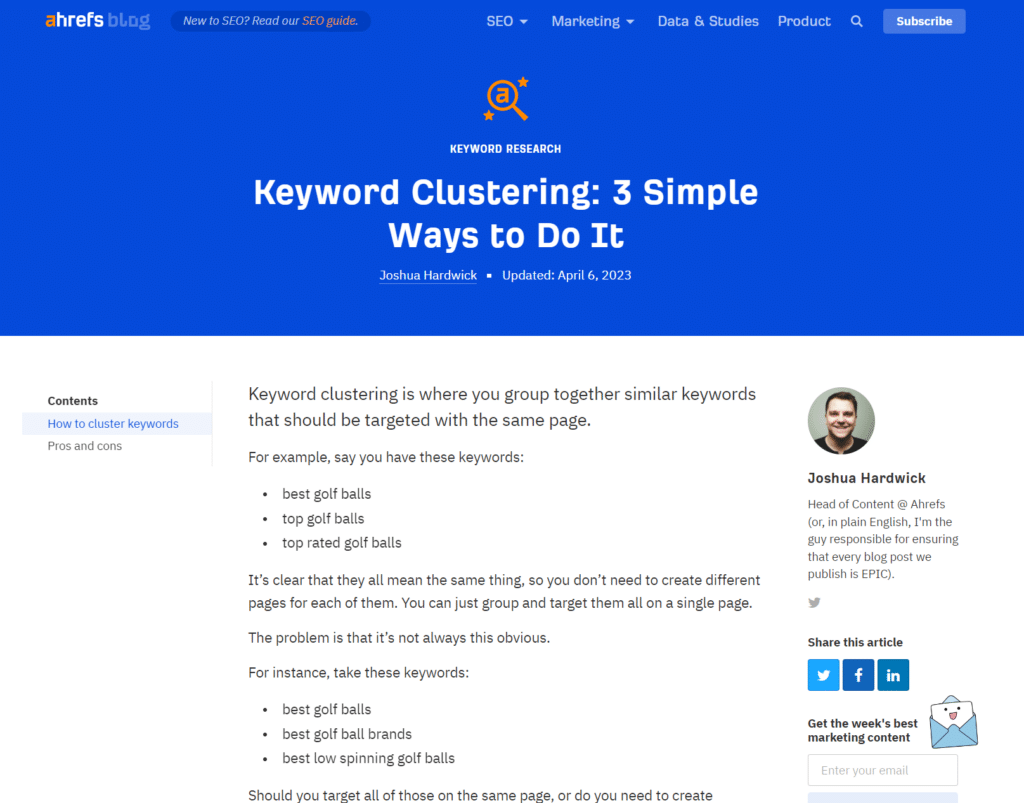
And it works.
The company has since crossed $100M in ARR.
No doubt the product-led approach plays a part.
Whether it’s articles, social media posts, or videos—whichever content you create, make sure it directly addresses customers’ pain points and offers an opportunity to position your product as an ideal solution.
With that in mind, do a double-, and triple-check in your keyword research tools that the keywords you’re going after reflect the themes or problems in your customer research. Review the search intent and keyword difficulty carefully.
Your keyword selection list needs to tick all these boxes, otherwise, the post is doomed before you even start writing.
And remember, the most important thing to do here is to create immensely valuable content that compels prospects to take the next step, be it downloading a bunch of lead magnets, subscribing to your SaaS newsletter, or signing up for a product demo.
Aim to create a SaaS content marketing strategy that delivers value consistently. It’ll eventually lead to revenue and ROI.
6. Use AI wisely
What do Microsoft, LinkedIn, and HubSpot have in common?
These bigwigs recently rolled out a bunch of AI-powered tools to help users gain back hours of their time.
New and established companies are jumping on the AI bandwagon, and understandably so.
These days, it takes only seconds to spin a decent 600-word article.
However, the drawbacks far outweigh the benefits.
These AI-generated content often sound templated and cliché. Not to mention the lack of depth and a large amount of misinformation.
Sure, you can use ChatGPT for short-term content production, like generating recruitment ads, creating a glossary of industry terms, and drafting a proposal from yesterday’s meeting.
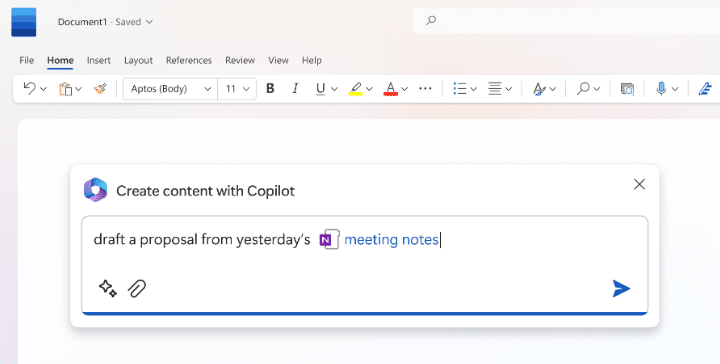
But if you’re selling high-ticket software products to B2B audiences like managers and C-suite executives, it’s going to take more than basic strings of sentences to leave an impression, let alone close a deal worth millions.
From a branding perspective, AI-generated content also does more harm than good. Journalists and writers back up their statements with unique research and data and quick-hitting insights. They’re not going to link to content with insufficient facts.
In short, avoid outsourcing analysis, critical thinking, or any long-term content production that requires a more nuanced level of understanding.
That’s not to say that AI is completely useless.
It does have its place in the content creation process.
For instance, Wordtune is a writing tool that rephrases and rewrites your writing. Is it a perfect tool? Far from it. In fact, I’d say that it’s nowhere close to a professionally trained editor.
But its AI-powered suggestions come in handy when you have a creative block. Highlight a sentence you want to edit, take your pick from the options generated from AI, and edit it further as you desire.

AppSumo is another company that uses AI strategically.
Note how the software marketplace uses ChatGPT to help users find cost-effective software deals. When users enter a query, it recommends a list of software tools shortly.

It’s a brilliant approach because users who come to the site are often overwhelmed by the selections and don’t know where to begin.
In a nutshell, use AI wisely.
This cool tech doesn’t help your content stand out. Rather, it buries them in a raging river of robotic writing.
Focus on creating content with unique expertise, originality nuggets, and diverse voices. You’ll have a much higher chance of standing out.
Post-Publishing Stage
Your content is finally done and there’s only one thing left to do: promoting it. These three strategies help you gain momentum in your SaaS content marketing strategy.
7. Distribute your content
In a picture-perfect world, new customers would flock right to our blog posts every single time we click the publish button.
Unfortunately, that’s not the world we live in. Even the biggest brand advocate isn’t sitting by the laptop eagerly waiting for a new post.
That’s why you need a distribution strategy.
Content distribution attracts more views to your content. By promoting your content across channels, you increase the chances of getting them in front of your target customer at the best possible time.
There are several ways to achieve this, and finding the best distribution strategy will take some time and practice.
Take summarizing long-form content on Twitter and LinkedIn, for instance. It’s popular among thought leaders like Amanda Natividad, John Bonini, and Ross Simmonds.
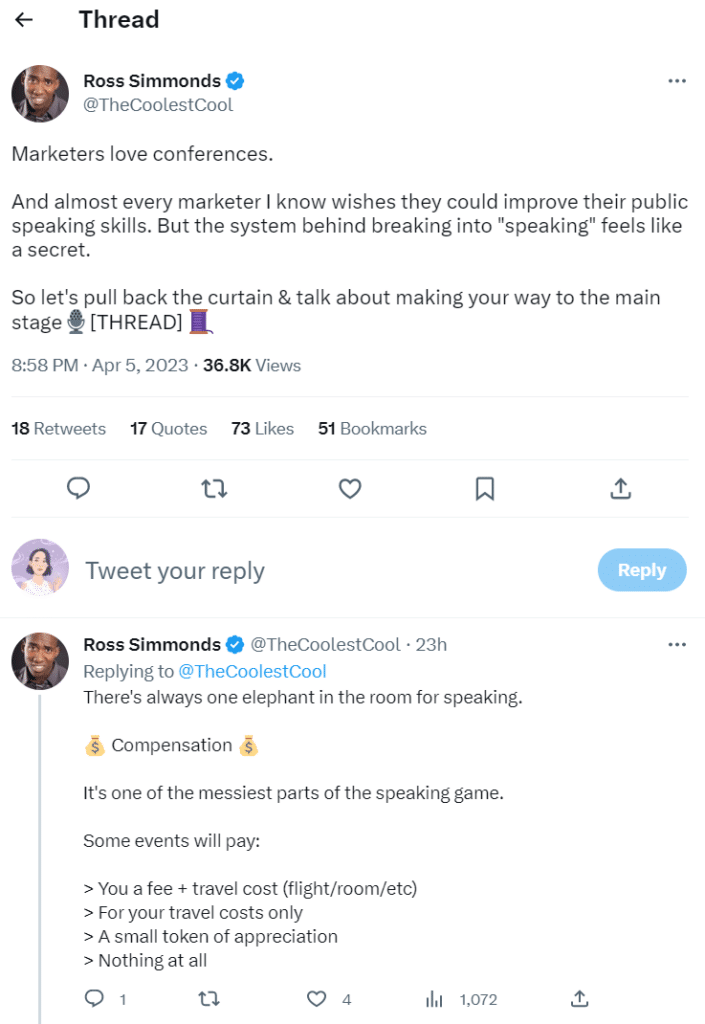
Building backlinks is one of the toughest nuts to crack, but when done well (i.e., you created unique content with hard-to-gather information), it can increase organic traffic by tenfold.
Paid ads are ideal for quick wins. If you’re looking to distribute time-sensitive content in the short term, they’re worth a shot.
Community content promotion was all the rage back then. However, with the constant algorithm changes on social media and more marketers clogging up the feed with irrelevant posts, it’s running out of steam.
All in all, YMMV.
Experiment to see which channels work best for you.
8. Repurpose your content
Modern customers today consume content in a variety of ways.
From skimming through long-form blog posts and watching webinars on-demand to listening to podcasts offline and surfing bite-sized video clips on TikTok, there’s one thing we know for sure: customers have different content preferences in all stages of the purchasing process.
That’s where content repurposing comes in. This practice recycles your existing content into new content formats and widens its reach.
The next time you finish creating a piece of content, reuse it and turn it into a different format. A case study video into quote graphics on Instagram; a blog post into an “office hour” live stream; an online course into a five-day email course; etc.

Go wild!
Repurpose your content to make it work for you. It certainly beats creating new content from scratch every single time.
9. Keep an eagle eye on content performance
With zero-click content gaining momentum, it becomes more challenging to measure performance.
We don’t have the perfect answer, except that you should measure the success of your SaaS content marketing strategy with your pipeline and revenue.
Track conversions to identify top-performing posts. This will help you decide the themes and content to double down on in your distribution to optimize engagement and sales.
Also, consider your business model and maturity stage when setting your key performance indicators (KPIs) and metrics.
For example, a SaaS company with a product-led growth motion will want to enhance the product experience and drive the compounding growth of new users. As such, it might measure SaaS metrics like the number of product-qualified leads, virality, and expansion revenue.
Use contact scoring tools like Breadcrumbs to monitor all qualified leads and customers across the entire journey. You’ll also want to build several scoring models for churn and cross- and upsell opportunities.
Qualitative data also comes in handy when measuring content marketing ROI.
Gather feedback from CS and sales (e.g., “Which case studies are working?”) and invest in a digital asset management solution to analyze which marketing materials are used the most often to close deals.
Keep a close eye on your content campaigns with a content calendar like CoSchedule. It helps you streamline the content production workflow and aligns everyone on the same page.
Final Thoughts
The rise in zero-click and AI-powered content is changing buyers’ content preferences.
SaaS companies that want to stay ahead of the competition need to shift their focus towards adding more value across platforms, not driving traffic to their own websites.
The brands that go beyond clicks in the avalanche of AI will emerge as undefeated champs in the content game.
FAQs
What is B2B SaaS content marketing?
B2B SaaS content marketing is a strategy where software companies build awareness, promote their products, and acquire customers through channels like SEO, email, social media, SEM, and videos, among others.
How do you create a content strategy for a SaaS?
We break it down into three main stages: planning, creation, and post-publishing.
Start researching your customers before moving on to creating your marketing assets and content. Set a budget to distribute and repurpose for wider reach. And keep a close eye on performance while you’re at it.
What are the types of SaaS content?
Common content types include white papers, SEO content (i.e., blog posts), support docs, newsletters, sales enablement (e.g., battlecards), on-demand webinars, social media, and email newsletters.

